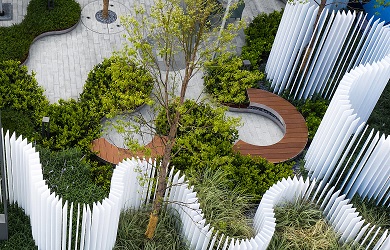Whether you have an area of your yard that is constantly flooded or you want to block out noisy neighbors, plenty of landscape design challenges can come up. These problems require thoughtful and creative solutions. The contrast in color, plant size and texture helps elements look unified. However, abrupt changes in these aspects can make the landscape look unstructured.
Table of Contents
ToggleSlopes
One of the biggest challenges homeowners face is dealing with slopes. Steep slopes are not only visually unappealing but, if left unchecked, can lead to soil erosion that compromises the integrity of your landscape. The best solution is to create a plan that utilizes both the natural features of your landscape. Landscape architects and designers in the Bay Area have creative landscaping ideas for slopes to ensure the success of your project. Incorporating a range of plants and landscape design ideas for slopes helps to combat the issue of erosion, as the roots of some plants act as soil anchors helping to stabilize bare ground. Plants also help slow the flow of rainwater, coaxing it into the bed rather than allowing it to run off the slope and wash away soil and debris. In addition, using a variety of plants, including natives and ornamental grasses, helps to provide color throughout the year, adding to the visual appeal of your landscape. Using retaining walls is another way to prevent soil erosion in your sloped yard. Retaining wall ideas include stacked stone, wood, and interlocking engineered blocks.
In most cases, retaining walls should be kept to a minimum in length. It minimizes grading and allows you to work with existing flat spots in the landscape and incorporate them into your design. If retaining walls need to be built, look for cost-effective options that blend with your home’s landscape style.
Focal Points
Focal points draw attention and direct the eye. They can be hardscape or plant elements and range in size. Ideally, focal points should complement and build on one another rather than compete with them. For example, if you have a very lush landscape immediately around your home, it would be nice to have a focal point like a water feature or sculpture that is a bit further away and helps you to see past the landscaping toward a more natural view. Sometimes focal points help with less than aesthetically pleasing aspects of the landscape, such as hiding an immovable structure or re-directing sight lines from a utility pole. They are often there to add beauty and charm to the garden. When choosing a focal point, consider its size and how often it will be visible. If you expect to be near the focal point, you usually only see it too large; if you only see it occasionally, a larger focal point may be appropriate to keep the landscape balanced and interesting. Focal points must also be maintained regularly to ensure they look their best. For instance, pruning and weeding will make them more attractive and prevent them from distracting the overall design.
Over Planting
Over-planting can prevent a landscape from becoming overly cluttered and distracting. It is when too many plants are placed within a space and begin to compete for the same resources. Properly balancing the elements of your design can help you avoid this problem. A good balance will include transitions, rhythm, and accents. The change occurs gradually when different colors, forms, and textures are introduced. Rhythm is the repetition of certain elements or objects within your design that can guide the eye around the landscape. Adding contrast will also help make your design more interesting. Contrast is achieved using contrasting colors, plant sizes, shapes, and leaf structures. Public perception is a significant factor in determining the success of any landscape design. While native landscapes have ecological benefits, they must also meet public expectations to gain public acceptance and support. Studies have shown that a picturesque, well-groomed appearance is the most desirable for public approval. Additionally, designers can add “cues to care,” such as walkways and viewing platforms that indicate that the landscape is not neglected. In addition, a landscape should contain a mix of mown turf and wildflowers or other native species to gain public acceptance.
Water Drainage
Many landscape design problems are related to water drainage. The original grading may not have directed water away from the home, and it can result in a wet yard, pooling, and even flooding when rainstorms hit. When this occurs, it can cost homeowners tens of thousands to repair. It is important to address drainage issues quickly. A qualified landscape drainage contractor can assess the problem and offer a solution to improve the yard’s look and keep the home and property safe. The type of soil on your property can also significantly impact drainage issues. Clay-type soils have poor water infiltration, which can cause a lot of standing water and surface compaction. It can lead to many landscaping challenges, including root rot for trees and shrubs. There are many ways to solve a drainage problem, from a French drain to a dry well. If desired, the right drainage system can be built into the landscape and designed to be hidden from view. A drain buried in the ground can be concealed with decorative rock and mulch. Another option is a low-profile drain with a slim opening that does not require a grate, making it nearly invisible. These drains are popular near gutters but can be used anywhere throughout the landscape to help with water drainage.







